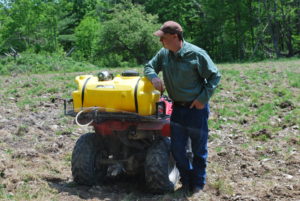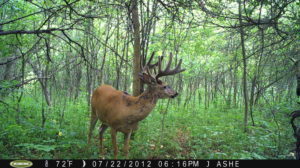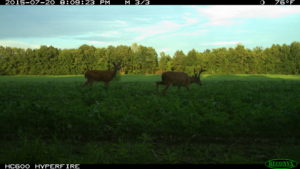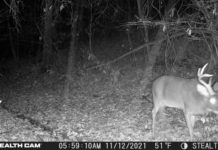Deer Hunter’s Almanac Video – July
This post was originally published mid-July in 2017. ‘Deer Hunter’s Almanac’ was created by Craig Dougherty with help from Jason Ashe for the Hunting Page. follow us on Instagram: https://www.instagram.com/thehuntingpagellc/
JULY
The deer are all decked out in their summer reds (coats, that is). The fawns are driving mom crazy trying out their newfound ability to run, jump and do all the things deer do, they can outrun most predators and chomp down the occasional mouthful of green stuff. The antlers are up and out and the bucks are with their bachelor buddies. It’s time to begin counting points and waiting for fall, (aren’t we always waiting for fall) deer food is everywhere and it’s there for the taking, it’s good to be a deer in July.
Deer in July
- Not only are summer coats a different color, they are much thinner and allow deer to move more about in the heat.
- Doe family groups and bucks typically occupy different habitats in summer.
- Does with fawns are beginning to tolerate the young they drove away during fawning.
- The bucks typically stay together in bachelor groups of 2-3 to as many as 5-6.
- Antler development is well under way, the main beams are formed and individual tines are identifiable, if not fully developed.
- Both bucks and does work mineral stations heavily in summer months, minerals are thought to contribute to antler growth.
- Summer fawn’s legs are generally fast and strong enough to escape predators.
- Crossing roads and the occasional predator is the biggest threat this time of year.
- Emerging vegetation is highly attractive to deer in early summer.
- Even though July fawns will feed on foliage, most does continue to nurse them.
- Antlers in velvet are easily damaged, bucks are very careful not to damage them.
- Summer feeding patterns of most whitetails will generally shift by fall hunting seasons.
Woods Work
- Food plotters would do well to wage war on weeds in July, it keeps spring plantings growing and prepares for fall planting.
- Weeds can be handled manually by mowing or cultivating or, if you want better results with less effort, spray with herbicides.

- Mid-summer is a good time to establish trails and set fall stands, and clear shooting lanes, and do your final woods work for fall.
- Weeds feed deer and provide cover abandoned fields and overgrown spaces should be allowed to come up in weeds.
- Electric fences will keep deer out of food sources until the food is ready to be eaten.
- It’s about time to begin getting plots ready for fall planting, do the heavy work now to save time later
Hunting-365
- It’s not too early to locate trees and shrubs that will be producing mast this fall, this is where you will hunt this fall.
- It’s not too early to put some arrows into the ten ring or sight in that new rifle, don’t wait until hunting season to practice.
- Beginning a fitness program in July will pay off this fall when it’s time to go and go some more.
- A regular routine of shooting will make a clean shot something you expect not something you hope for.
- Setting cameras now will give you an idea of who is in the neighborhood but travel patterns will most likely shift.
- Setting out too many cameras can push deer to use other areas, some deer shy away from camera activity.
- Antlers are sufficiently developed to do some early “looking” for Mr. Big stay far away and keep the pressure off.
- Don’t expect Mr. Big to be feeding in the same places in October he is in July.
- Any time is a good time to hunt predators, you can go golfing or kill a coyote.
- Are you helping your farmer friends pick up those bales of hay, a little courtesy can lead to an invitation to come back and hunt.

- Summary – Early summer is critical for antler growth. Keeping mineral sites fresh, energy, and protein sources intact will start antler growth as early as biologically possible leading to increased inches. Late summer mineral intake will start to tail off as mineral concentrations in plant material increase due to dormant non-growing season. During late summer energy and protein need to be available to the animal with decreasing quality of dormant season plants.
“Digging In” notes from our sponsor Big & J Attractants:
Summer
Early Summer is the most critical time for protein and mineral supplementation for both bucks and does as far as antler growth and fawn production. Bucks are at the time of year where they have the greatest protein requirement because antler growth is in full swing and does are at peak requirement due to milking fawns and peak lactation which is the single largest nutrient draw on the females in the herd. In addition, during the early parts of the summer while grass is still green and growing, mineral supplementation is a must because of the relatively low mineral composition of grass and the dilution effect of stage of growth. However; as vegetation begins to go dormant and plants prepare for fall and winter the concentration of mineral in plant material increases and activity at mineral sites will begin to slow or even stop. Why? Deer are getting most or all of the mineral they need from what their habitat provides. This date is region specific as to when mineral consumption will slow or stop but should be expected to occur somewhere between August and September on average. In later summer as vegetation quality continues to decrease it is important to shift the focus of supplementation to energy as bucks and does are preparing for the rut.
Suggested Big & J supplements for Summer –
- Legit – Great source of Ca and P needed for bone/antler growth. Would meet the deficiency in the natural habitat. Includes trace minerals that are essential to reproductive function and healthy bone growth/antler growth. Apple flavored for attracting power. When to feed: Late Winter through early Summer.
- BB2 granular and cube – Aside from the value as an attractant BB2 is over 90% digestible which is greater than corn. In addition, the energy comes primarily from digestible fiber and fat instead of starch and fermentable carbohydrate. This leads to a near zero chance of acidosis or digestive upset. The protein content of BB2 is guaranteed to be 18% as a minimum. Mineral content is not enough to meet the needs from a Ca standpoint but does include approximately 1% calcium and would meet all of the P needs, essential components for healthy antler growth. Given the energy content and the protein content, BB2 is the total package in attractant form; however; additional mineral supplementation is needed to maximize genetic potentials of production. When to feed: year round
- Liquid Luck – Great addition to any arsenal of attractants. Can be fed straight by pouring on the ground or stump that you would like to have some help grinding down. In addition, liquid luck can be added to other ingredients such as corn to increase the palatability, protein profile and bring salt/sodium content to an optimal level. Even though the protein level is only 8% the protein that is provided is mostly UP. Also, contains Ca and P to help balance the mineral needs in your deer herd. When to feed: year round.
- Melt Down – Great source of Sodium which would be next part of the puzzle once Ca and P are met. Sodium is needed for cellular function including amino acid (building blocks of protein) transport. In addition, deer have an appetite for Sodium meaning they will consume it even if the body does not need it. When to feed: Late Winter through early Summer.



















![The Best Deer Camp Chili [VIDEO] Deer Chili Ingredients, Tomatoes, Chili Spices](/wp-content/uploads/2015/10/Deer-Chili-Deer-Camp-Recipe-218x150.jpg)
![How to Call Elk Early in the Season [VIDEO]](/wp-content/uploads/2016/08/byers003-218x150.jpg)





![Idiots Disturb Hunter: How Would You Have Handled It? [VIDEO]](/wp-content/uploads/2015/10/DSC00110-e1474487693878-100x70.jpg)
![Albino Buck Shocked to Shed His Antlers [VIDEO]](/wp-content/uploads/2015/10/AlbinoDeer-100x70.jpg)